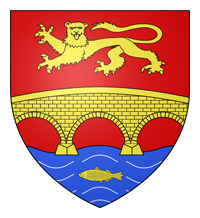 |
Welcome to Pont-d'Ouilly |


History - Le Rocray
Le Rocray
The factory at Le Rocray is not part of Pont-d'Ouilly. It is actually in Cahan, which is in the Orne departement. Only the houses are in Calvados.
The original factory consisted entirely of the large house, which is situated on the left bank beside the Noireau river : it was a textiles mill.
We know that it was built before 1830 because the Napoleonic land register indicates that Florentin Leconte owned it.
The power needed to run the factory was provided by a water wheel, situated behind the house, which was fed water via a channel, which still exists as you enter the courtyard in front of the houses.
At this time the Noireau had a branch which crossed the courtyard diagonally and passed between the house-factory and the Arclais road : thus the house was on an island.
The second factory dates from 1865. At this point the channel feeding the water wheels was excavated, as well as the weir across the Noireau, which still exists.
It is likely that, after this work was completed, the branch of the river, which no longer exists, dried up and was filled in.
The main building of the new factory was constructed between the Noireau and the new channel.
On the right bank of the channel there was a building, including a brick chimney, which housed the power plant.
On the left bank of the channel, in front of the main building, there was a single-storey building equipped as offices.
The new factory, like the old one, was built as a textiles mill.
Power was provided by two water wheels and a steam machine.
The old factory was turned into a house and became the home of the owner of that time, a M. Pingley.
No doubt, as a celebration of the relative importance of the development, both for the time and the region, in the same year (1865) the Great Cedar, that everyone admires today, was planted in the garden in front of the house.
M. Pingley was succeeded by M. Nerou and then by the Tissages Réunis Company, which exploited the weaving carried out at both the Le Rocray and La Pautiche factories; then the Dickson-Walrave Company, which turned the factory into a cotton laundry. This company built a dryer, a sort of hangar, situated opposite the offices, extending the main building towards the west.
In 1928, after three years of closure, the factory was bought by the Ferodo Company, which installed a workshop for asbestos material impregnation. After this, mediums for brake lining were made there. In 1979, this factory employed 168 people (2 executives, 30 foremen and 136 workers). It closed in the 1980s, at which point there were still 120 members of staff.













